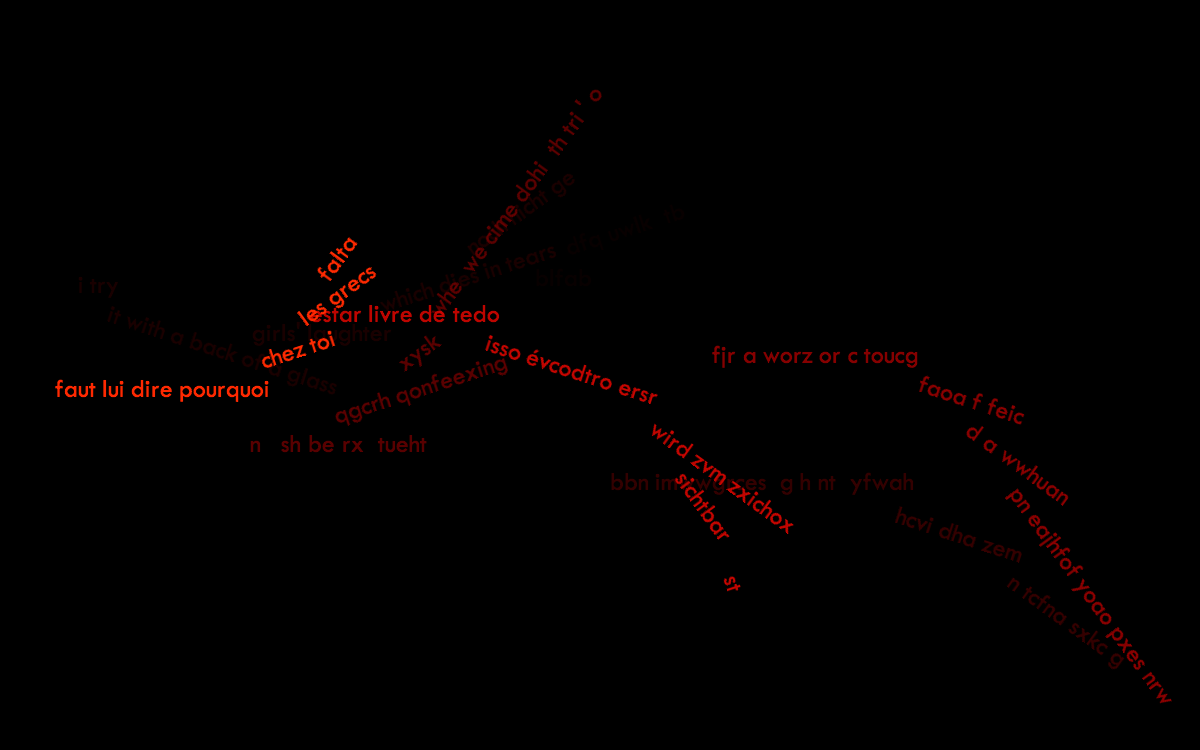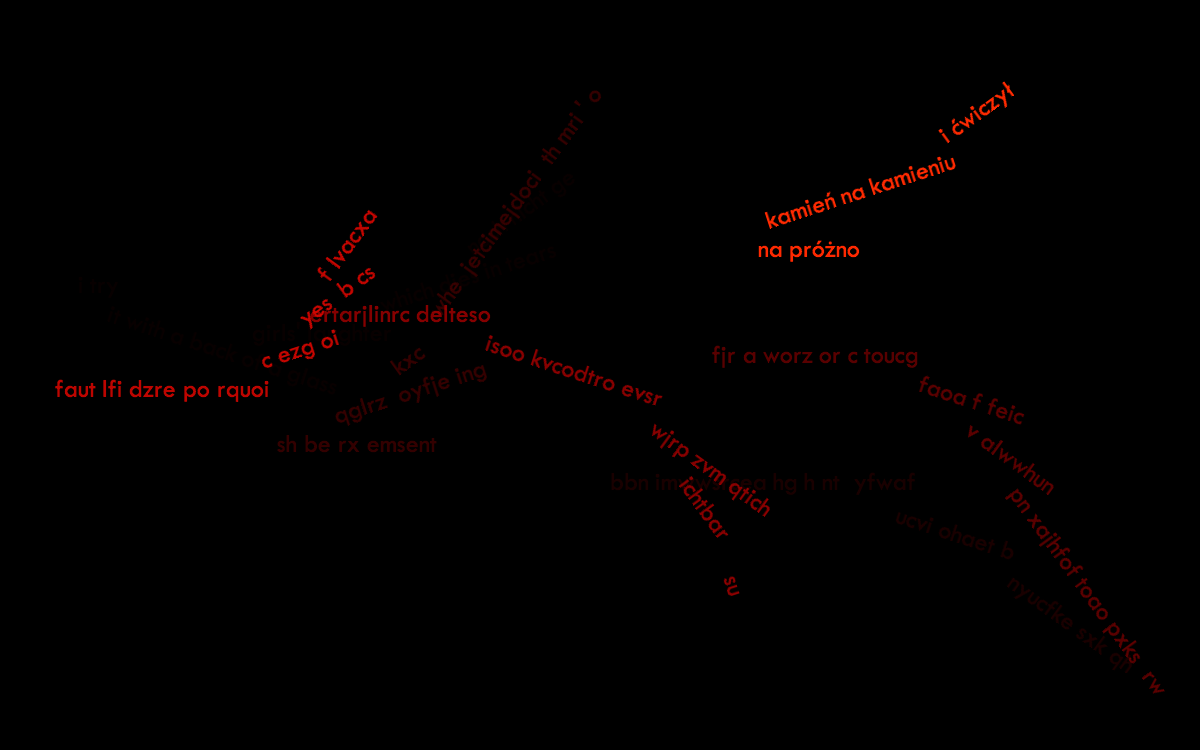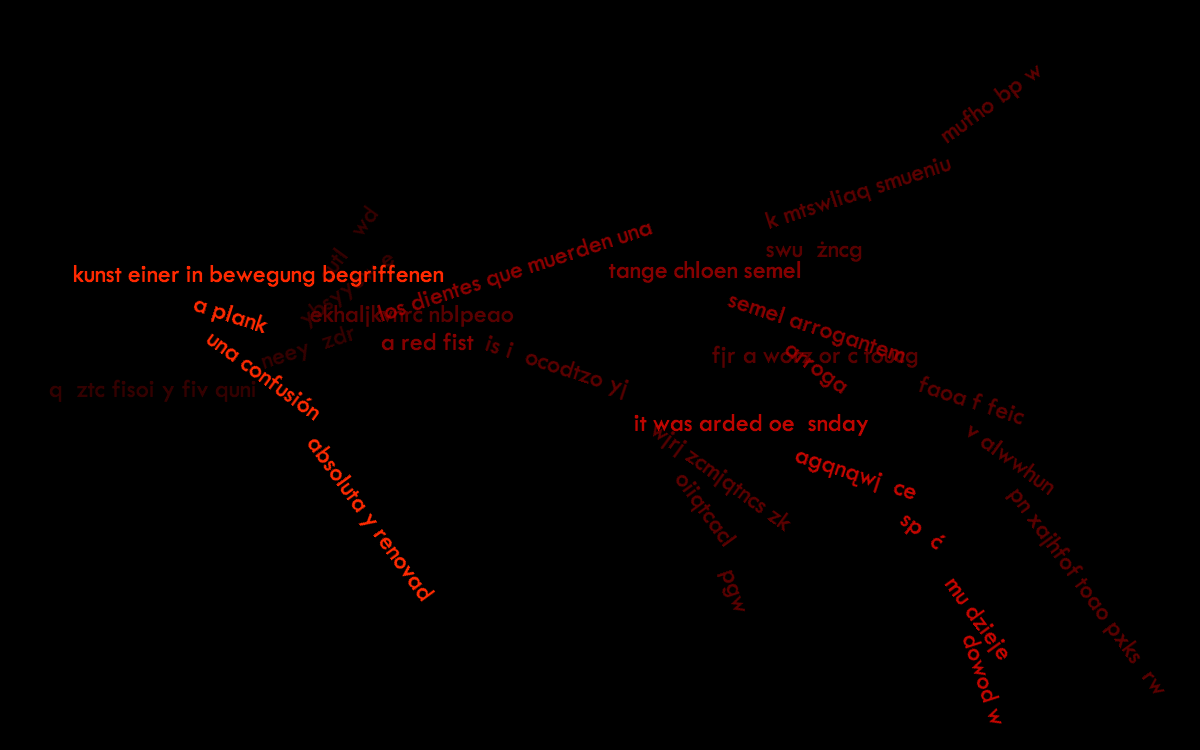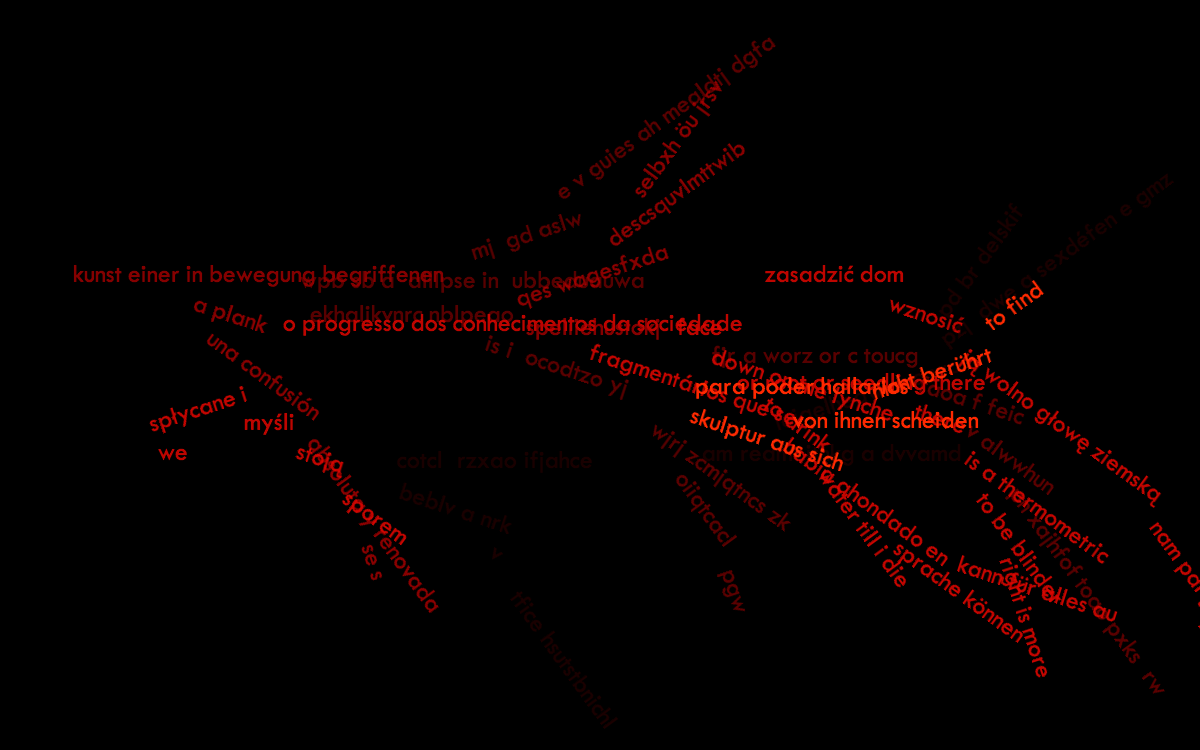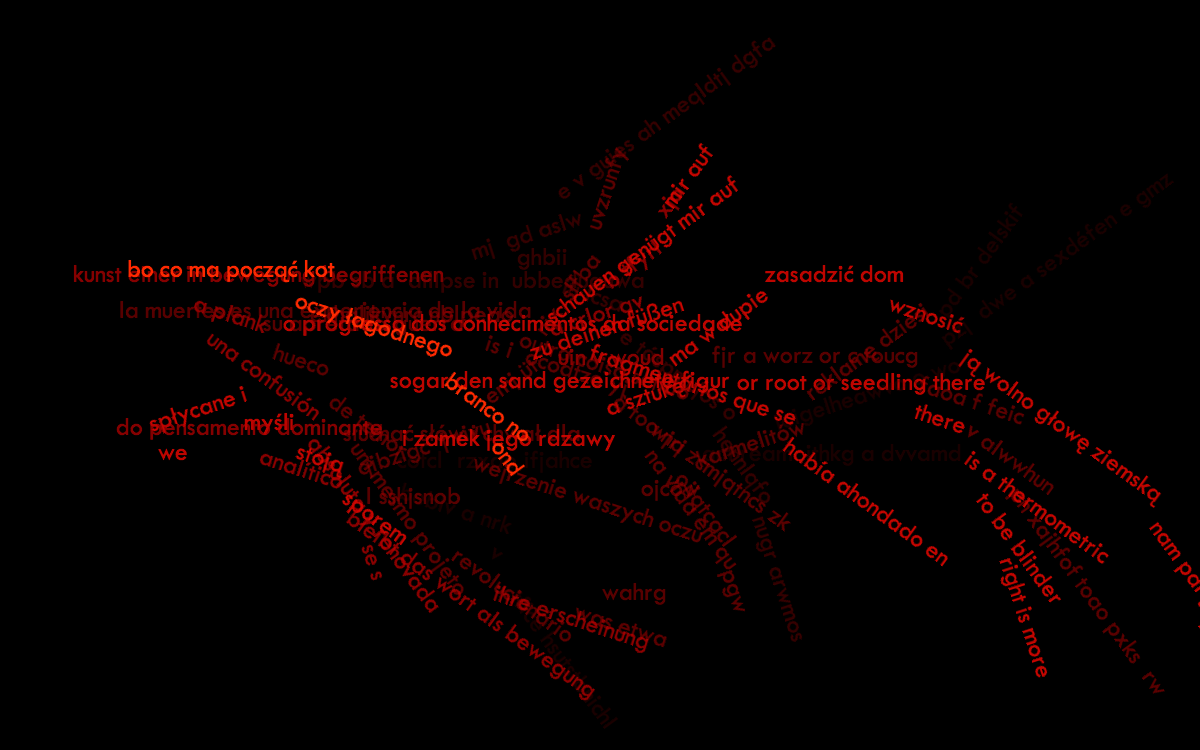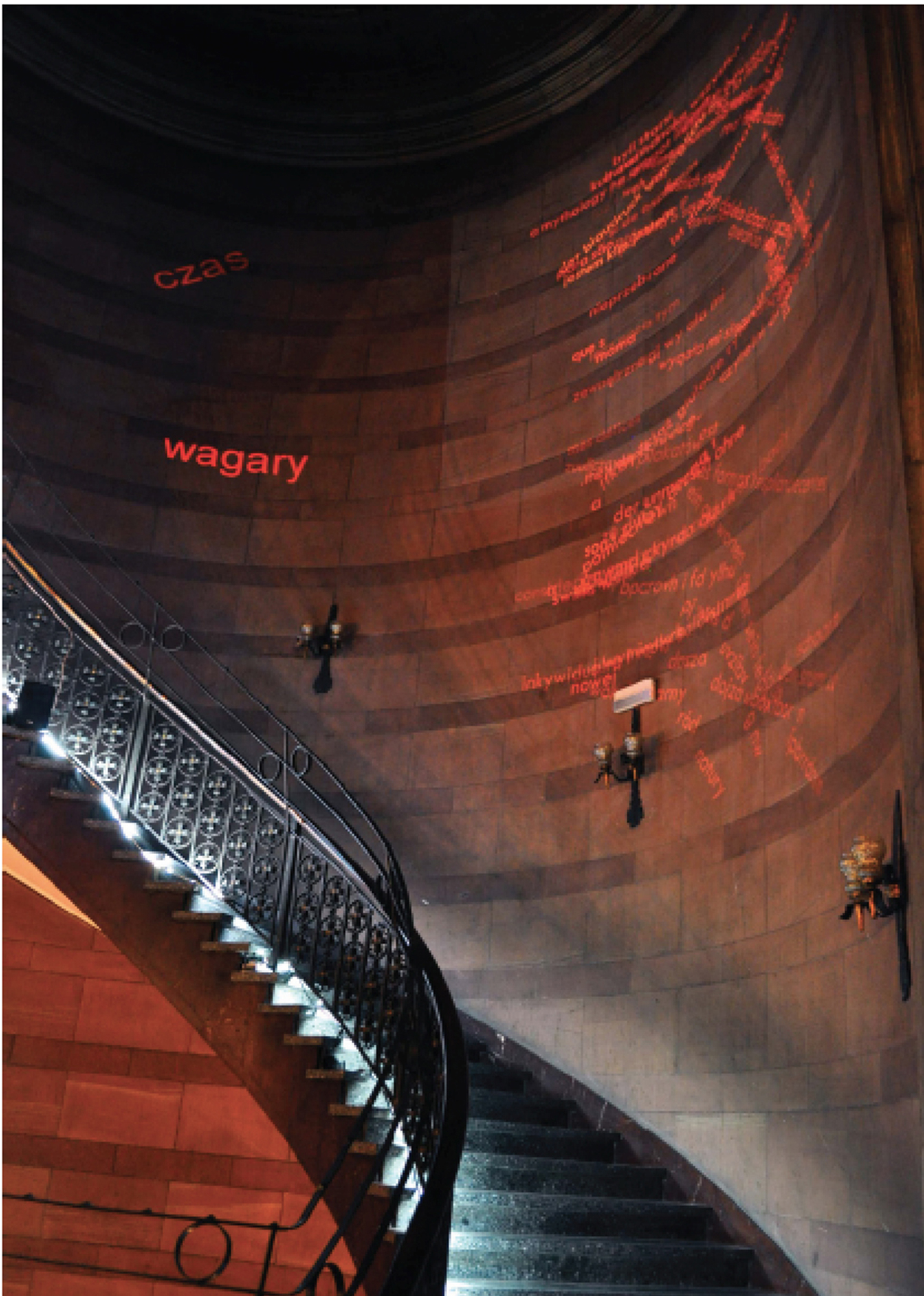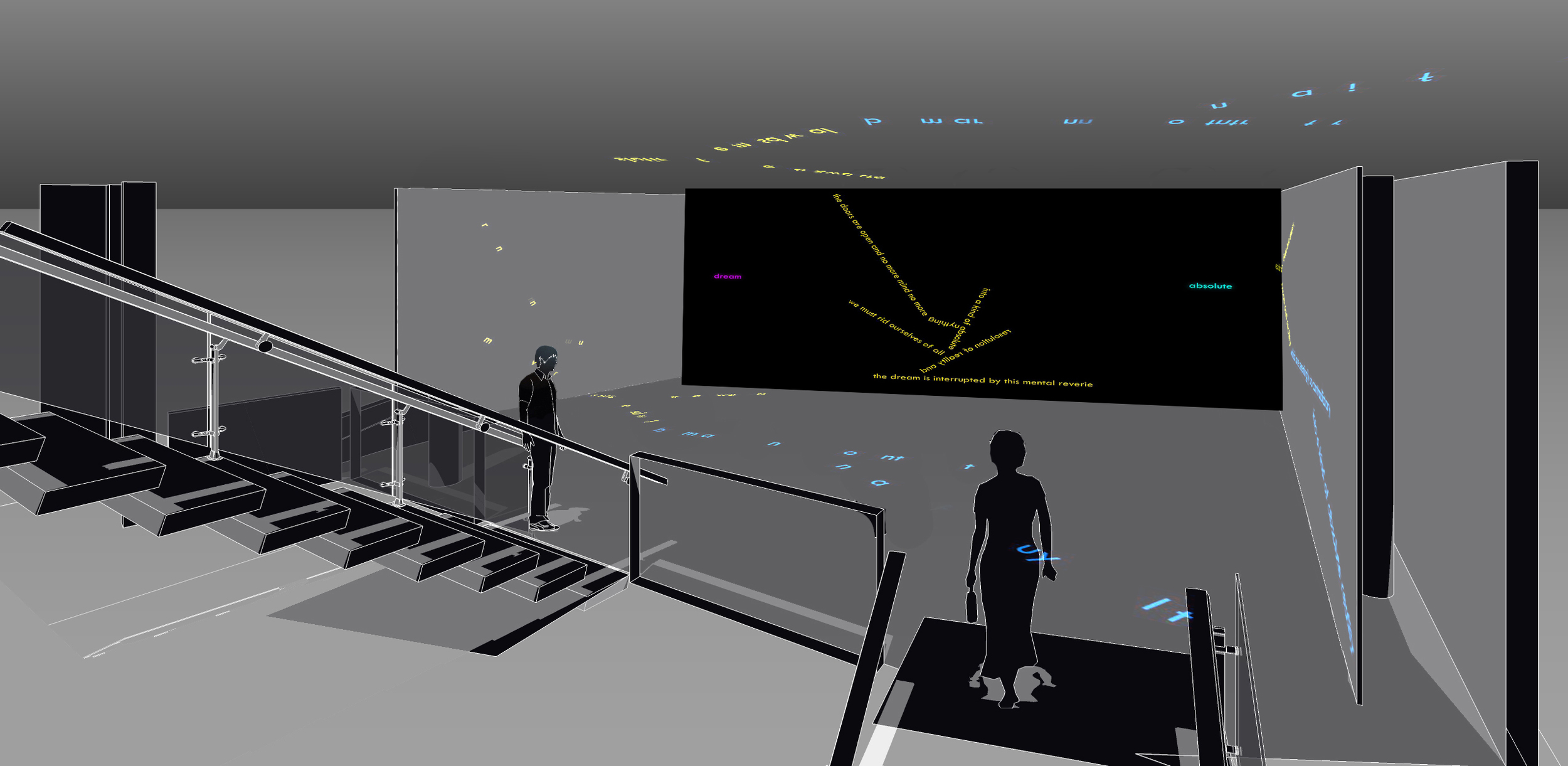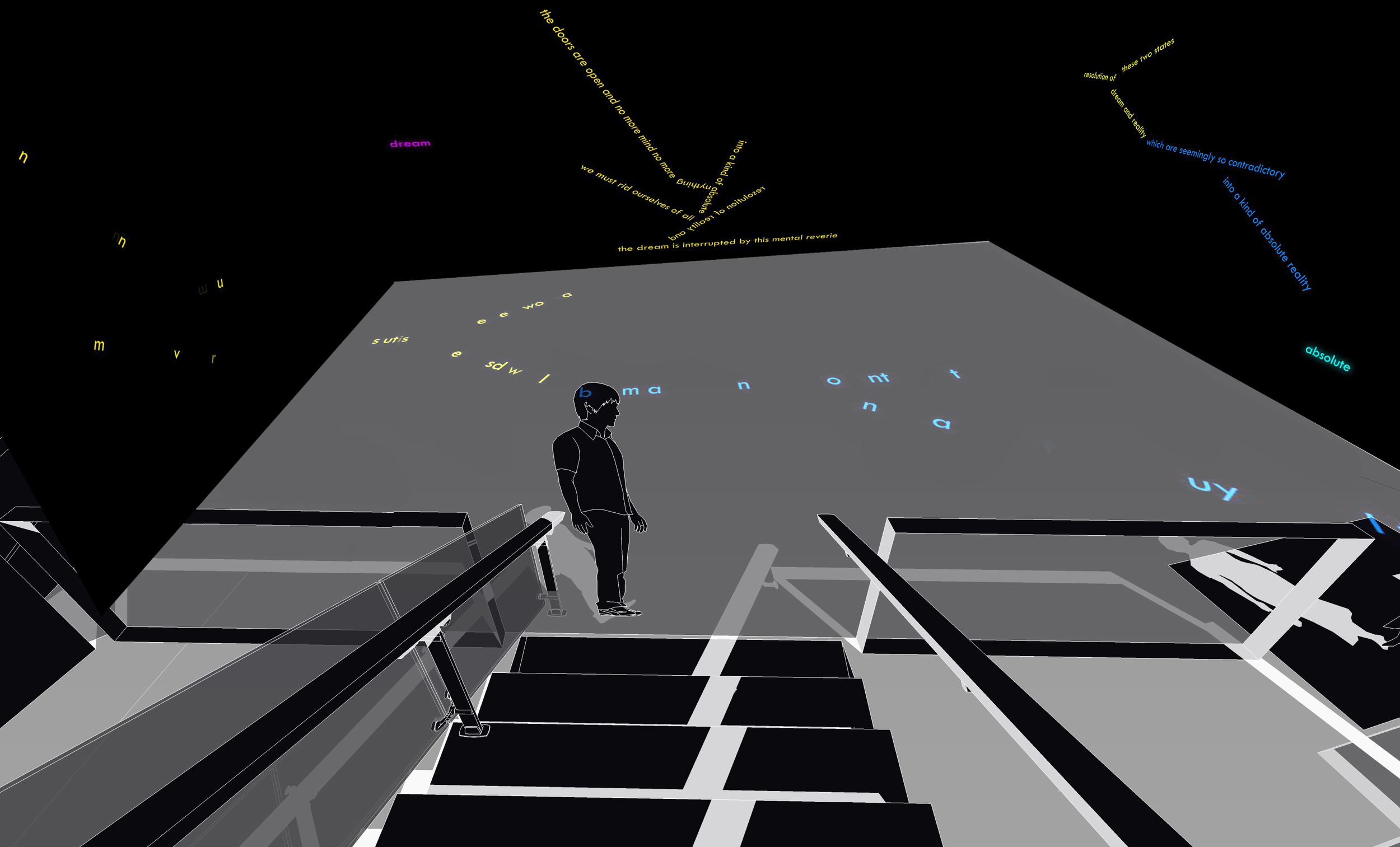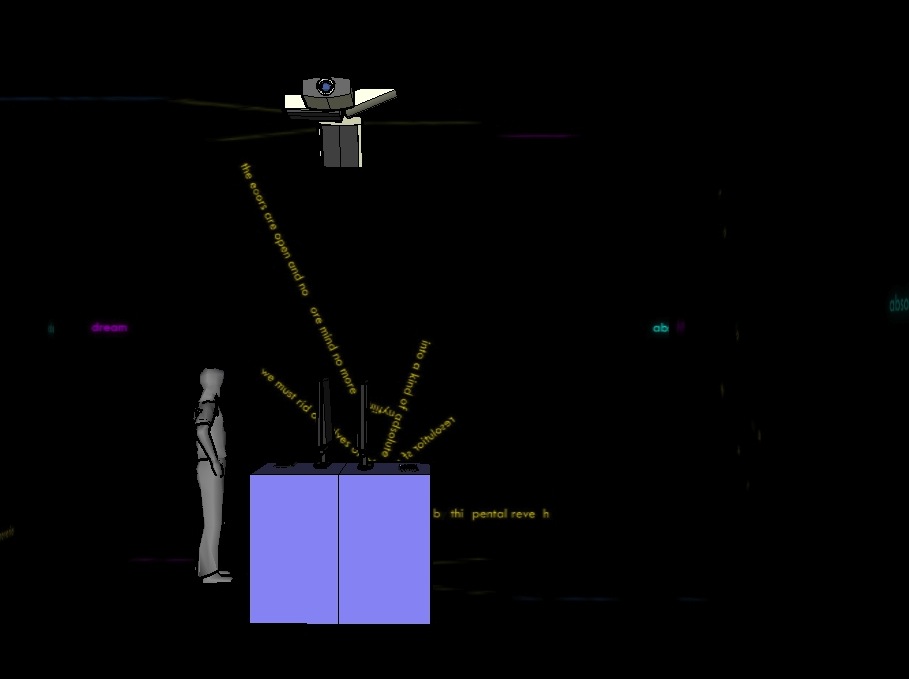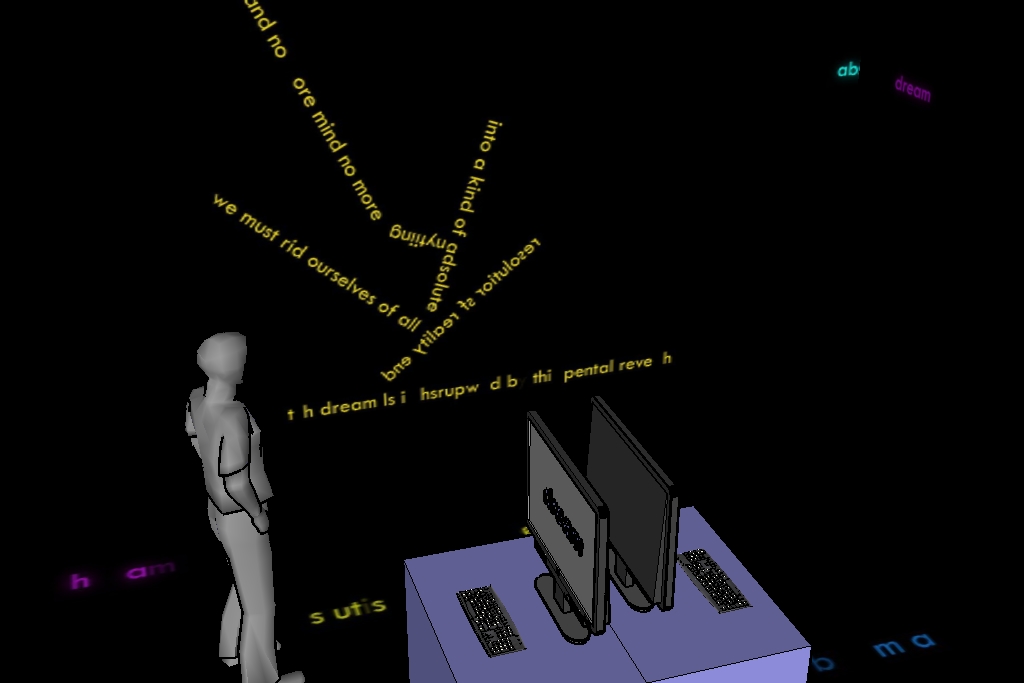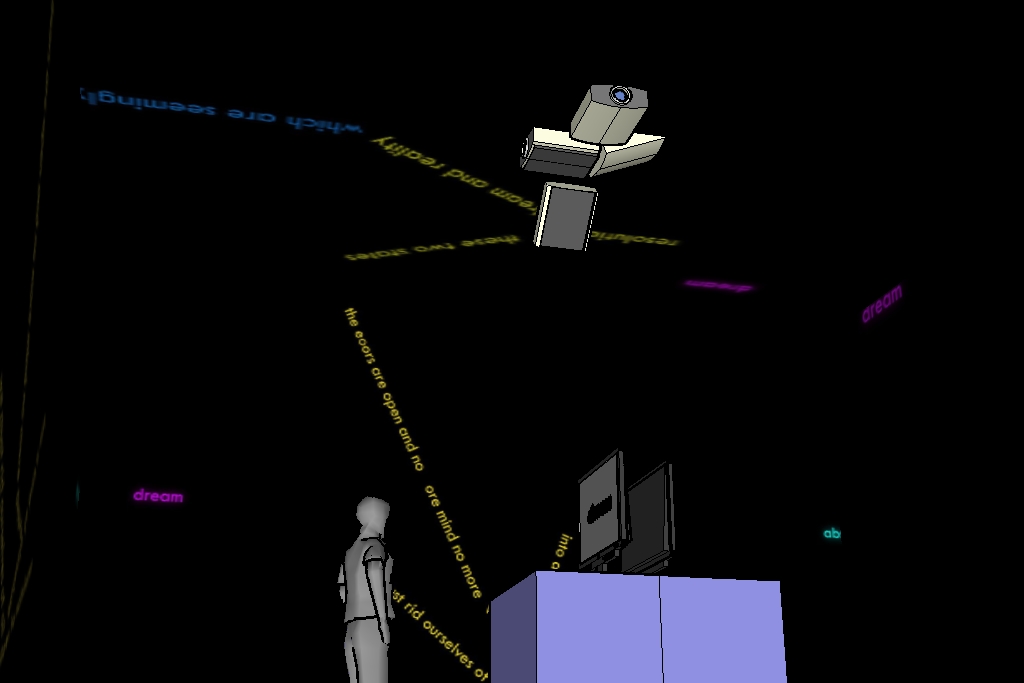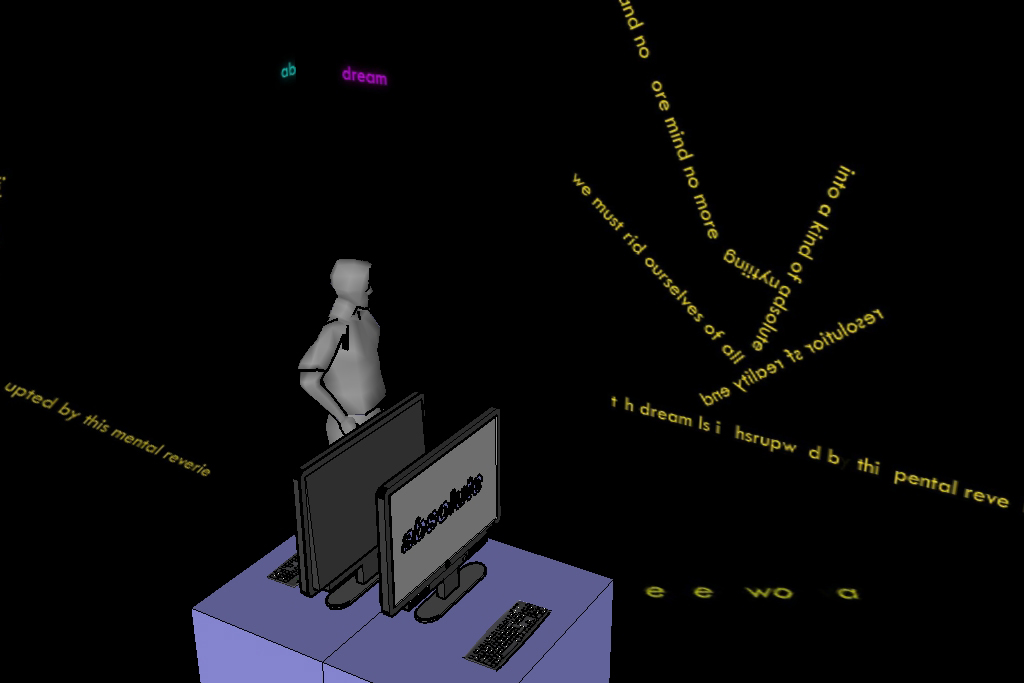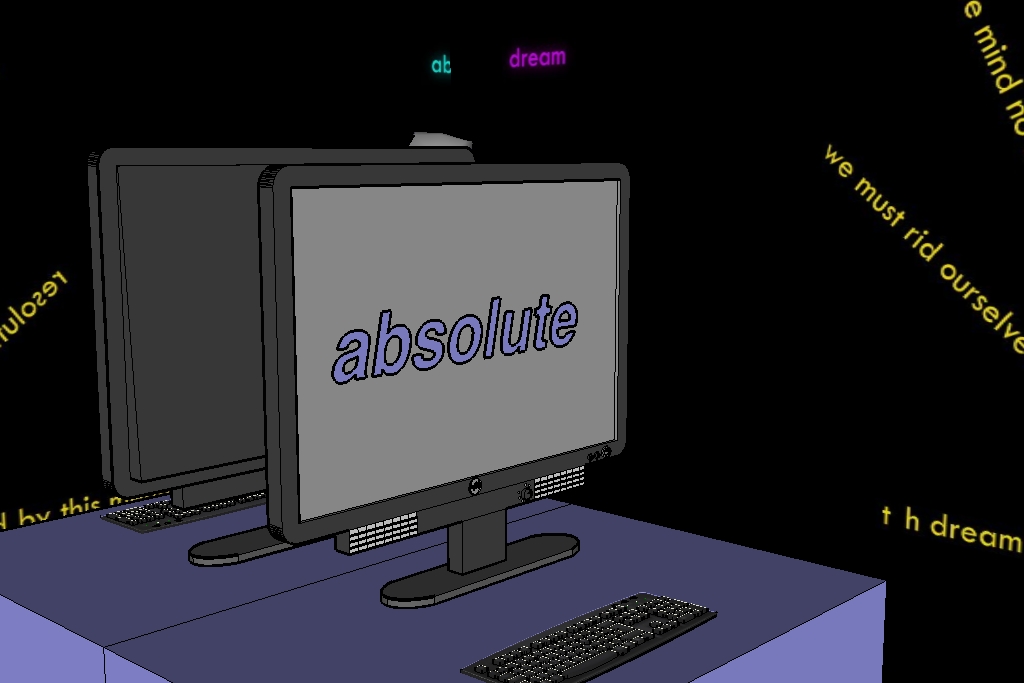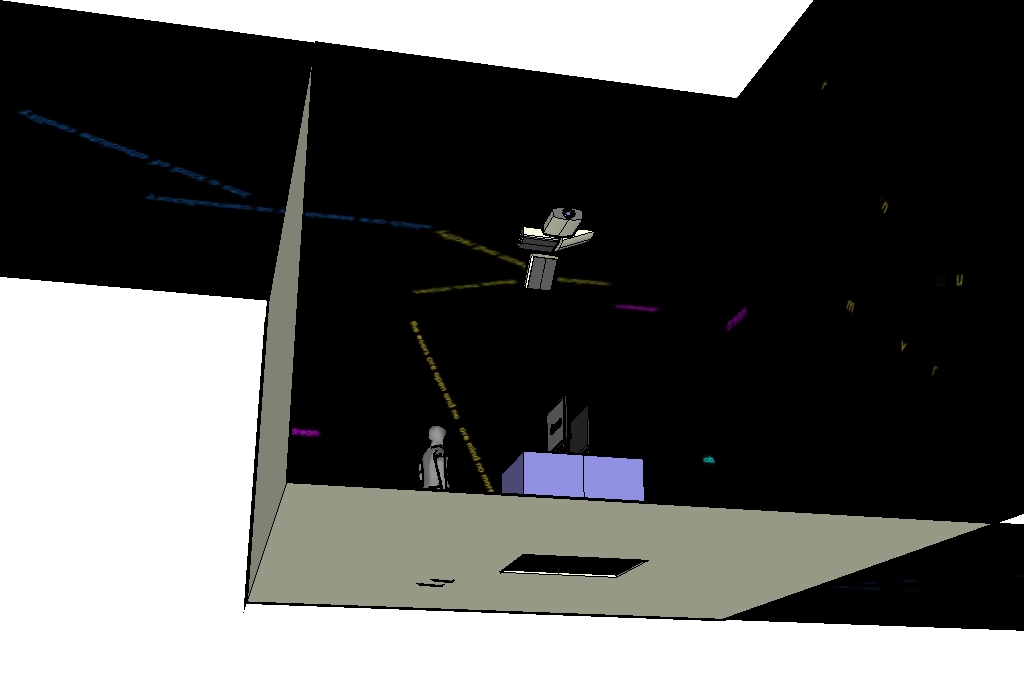UNLANGUAGE
(2012)
Adriana Varella/ Heather Dewey-Hagborg (collaborator)
interactive computer program and 10 channels video projections.
The interactive projection/installation starts with 2 volunteers-participants who each will type one word on two distinct laptops placed on opposite sides of the room, attempting to create a telepathic experience. Based on a custom computer program, these 2 words will become associated and develop into an unpredictable phrase that the computer will extend into different languages, without the control of the artists’ original setting. The associative phrase will branch out into different directions, like a rhizome, creating many bifurcations and new possibilities of associations and meanings. This interactive unfolding will be projected onto walls, ceiling, and floor of the gallery. Each letter that is formed will be tied to a specific musical sound referencing the body’s incidental noises, creating a unique symphony for each word and phrase. In this way the sounds of each letter are remapped to a new alphabet of noise, making literal the arbitrariness of the spoken word.
Suddenly all the words will start to collapse.
"unlanguage" Mediations Biennial THE UNKNOWN - Poznan / Poland / 2012
Video "unlanguage" Mediation Biennial THE UNKNOWN - Poznan / Poland / 2012
Unlanguage
This work is a site specific created specifically for the Nowa synagogue in Poznan, to celebrate Stefan Lux that was a Slovak Jewish journalist, who committed suicide in the general assembly of the League of Nations during its session on July 3, 1936. He shot himself in order to alert the world leaders of the rising dangers of antisemitism, expansionism, and militarism.
The process starts with 2 volunteer-participants that will each type one word creating an experience of telepathic connection. Based on a custom computer program, these 2 words will develop into an unpredictable phrase that the computer will extend into different languages, without the control of the artists' hands. This generative poem will branch into different directions, creating many bifurcations and possibilities, and it will be projected onto the walls, floor and ceiling of the space. Each letter will be tied to a specific sound, referencing the body, and incidental noises, creating a unique symphony for each word and phrase. In this way the sounds of each letter are remapped into a new alphabet of noise, making literal the arbitrariness of the spoken word.
Suddenly all the words will start to collapse…
Universal language of the Patriarchy
The arising of the language is a fundamental fact in the human history. Human societies as they exist today wouldn't be possible without the language, and vice versa. This is an indication that language and life in societies should have developed in synchrony. From the Genesis that gives Adam (not Eve) the ability to speak and name things, to the myth of Babel that shows how different languages can bring confusion among human beings, the history of language shows how powerful, sexist, binary, patriarchal and decisive it is for human behavior.
Why destroy the language?
Sovereign of the civilization, writer and recorder of History, emperor of communication; language establishes meanings and definitions applied as unquestionable rules. Without asking for permission, the linguistic laws have made our own thoughts and perceptions their property, disconnecting us from our own abstract sensory apprehension and comprehension of the outside world. If language allows us to express ourselves and communicate with each other, it also separates us from our own original and unique perceptions and sensations by trying to name them, capture them and control them. Known as the mediator to transmit "knowledge" (a concept that it has defined and therefore limited), language continuously repeats the same motionless and obedient definitions, which imprison the individual feelings and sensations. However, perceptions are beyond explanations, and cannot be named without being repressed.
In its attempt to give everything a specific signification, language creates a dangerous necessity for explanations and comprehension according to its own alphabetical and grammatical logic. It colonizes the human instinct, organizes the intuitions, governs the spontaneity, prescribes our views, regulates our movements, homogenizes our imagination, structures our dreams and impulsions, appropriates our thoughts.
Language is a social agreement that builds codes of representations and categories. These limitations create a fictitious unity, which origin is exclusively a linguistic reality established inside a cultural dialectic based on binary structures. So, if language is responsible for sexual and gender division, the feminine and the masculine simply don't exist outside of language. If the majority of children have a decent command of the language at the age of two, how can they possibly become independent interlocutors? If there is a patriarchal/universal grammar inherent to a social contract, how can the freedom of speech possibly exist? How can we express ourselves without being oppressed and limited by linguistics? Do I feel oppressed by this word? How do I feel? What is the possibility of criticizing the language on libertarian principles? Is a form of metalanguage capable of offering criteria to evaluate the language itself? What about a de-construction or maybe an abstraction of the language towards a translanguage? What are the possibilities for the realization of a communication ideal?
Everybody is at the same time an user and creator of the language, so it is up to us to realize an analysis of the language through specific concepts. The intention of this work is to dissect the impact of language in its unconscious dimension, by questioning the strategies and structures that precede the learning of any specific grammar or vocabulary, belonging to a cerebral initial stage referring to a corporeal-behavioral language.
We will try to use language against language so as to subvert it and free it from its conditioning role. We will try to transcend it until its incoherence becomes its coherence. Beyond interpretation, representation and linguistic boundaries. Associated with Artificial Intelligence, the branching poems will gradually destroy themselves letter by letter, revealing the disorganization and chaos that exist before and beyond language. In the unconscious, the irrational, the inexplicable, the unknown. Language cannot capture sensations; Language organizes meanings and meanings are rules, conventions, instruments of power. We want any meaning to be out of order, out of duty, lost, collapsed.
To accomplish this, the computer programming will combine multiple languages so as to erase cultural boundaries, introduce contradictions, create dissonances and welcome coincidence as the true author of the poem. Piece by piece, the unpredictable ramifications will break down all grammatical usages, all time and space values, all ordinary connections with context. The poem will find its substance in its ruins, its personal dust, its barbarity, its anarchy, its own research of freedom and autonomy. The essential is the movement of the words, the sound, the rhythm, the melody of the sentences, the emotional color of the letter. This work is also a conversation, reflection and celebration with the Dada movement and artists/theorists: Hugo Ball (poetry without words), Antonin Artaud, Shulamith Firestone, Judith Butler, Jorge Luis Borges, Emma Goldman, Monique Wittig, Michel Foucault, Mallarme and James Joyce (Finnegan's wake).
If language is perceived through social interactions and conditioned by it or it is a byproduct of the relationship of the environment and the mental structures in which the individuals accept being governed and with it form the validity of the social contract.....I particularly protest and denounce this and I refuse to be integral part of it.
For more than 20 years Adriana Varella has been working in various projects, including public art projects such as large scale video projections and site specific projects for museums in several cities. The more relevant and intriguing project to date is the Anarko Art Laboratory that she created 3 years ago with her collective in the Living Theater, NYC. Defining itself as a living organism immersed in multimedia developments, the Anarko Art Lab forms a collaborative visual language based on interactive improvisation, which relocates territorial positions of power and property. Unpredictable and unexpected, it is simply opening to the unknown.
NÃO-LINGUAGEM
(2012)
Adriana Varella/ Heather Dewey-Hagborg (colaboradora)
Software interativo especialmente criado para o projeto com 10 canais de projeção de vídeo e computadores
A interação começa com dois participantes voluntários. Cada um deles digita uma palavra em um dos computadores localizados em lados opostos da sala, na tentativa de obter uma experiência telepática. Por meio de um software de inteligência artificial, as duas palavras são combinadas, sem o controle do artista, de maneira que criam ramificações e desdobramentos múltiplos de poemas em idiomas diferentes que são projetados por todos os espaços da sala, paredes, chão e teto. As frases criadas são randômicas e, como um rizoma, trazem novas possibilidades de combinações, associações e significados, nunca se repetindo, fazendo de cada momento um instante único. Cada letra emite uma nota musical em referência ao barulho acidental do corpo, criando uma sinfonia única para cada frase/palavra. Dessa maneira o som de cada palavra faz um re-mapeamento de um novo alfabeto sonoro.
De repente, todas as palavras de desfazem para iniciar um novo processo com novas combinações.
